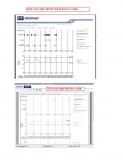definition of flow limitation
Re: definition of flow limitation
quote="Papit" With my AHI reduced to almost nothing, what I still don't understand is why my FL graph is showing so many and such strong flow limitations throughout my sleeps every night since June when I got the machine. (I also notice a great amount of continuous "ragged hairy" fluctuations in both the Flow and Pressure graphs that suggest the Adapt is working hard continuously all night long.)
ResMed tells me that the FL graph/data does offer treatment-related information, but they won't forward it to me as I'm a patient, not a doctor or medical professional.
I have the same questions. I have my first appt with a sleep doc in Sept and I intend to bring my printouts and ask that very question. My AHI is great, my pressure is set to allow it to go "higher than it wants to" (9 min 14 max, averages 11.5), the pressure is varying quite a bit, so I know its working against something LOL, and I am still getting wild flow limitations graphs.
Guess that's why we pay those sleep docs
ResMed tells me that the FL graph/data does offer treatment-related information, but they won't forward it to me as I'm a patient, not a doctor or medical professional.
I have the same questions. I have my first appt with a sleep doc in Sept and I intend to bring my printouts and ask that very question. My AHI is great, my pressure is set to allow it to go "higher than it wants to" (9 min 14 max, averages 11.5), the pressure is varying quite a bit, so I know its working against something LOL, and I am still getting wild flow limitations graphs.
Guess that's why we pay those sleep docs
_________________
| Mask: Swift™ FX For Her Nasal Pillow CPAP Mask with Headgear |
| Humidifier: S9™ Series H5i™ Heated Humidifier with Climate Control |
| Additional Comments: Sleepyhead software, Pressure 9-14, EPRx1, Pad-a-cheek barrel cozy, Resmed hose cover |
- Stormynights
- Posts: 2273
- Joined: Wed Mar 10, 2010 7:01 pm
- Location: Oklahoma
Re: definition of flow limitation
I had the older S9 ASV but now I have the newer one and my graphs are shown. My older one was less than 2 years old.Papit wrote:Stormynights, when did you get your VPAP Adapt? Only the more recently made units of the same model name offer the FL graph for real.Stormynights wrote:My Sleepy Head graphs don't show a separate flow limitation graph. It is checked under graphs in preferences.
_________________
| Mask: AirFit™ P10 For Her Nasal Pillow CPAP Mask with Headgear |
| Humidifier: S9™ Series H5i™ Heated Humidifier with Climate Control |
| Additional Comments: Pressure EPAP 5.8 IPAP 9.4-21.8 PS 3.6/16 S9 Vpap Adapt ASV |
Re: definition of flow limitation
I hope I did this right. I can only show you the difference in my printouts. Wow... that is big, but you can see the difference most clearly!


Peace beings with each of us as individuals
Re: definition of flow limitation
Finally. We find (e.g., oak, barbaraz, me) xpap-ers who have low treated AHI, but high Flow Limitation graphs. Any others? I hope you guys can get your docs to request ResMed's (or Respironics's) treatment adjustment guidance on this from them, preferably in medical article form. My doc still hasn't gotten back to me with anything. Respironics had the lead for awhile in the flow limitations area. ResMed's more recent inclusion of the FL graph, in the newer S9 Adapt anyway, is playing catch-up baseball.
Guess that's why we pay those sleep docs
I have the same questions. I have my first appt with a sleep doc in Sept and I intend to bring my printouts and ask that very question. My AHI is great, my pressure is set to allow it to go "higher than it wants to" (9 min 14 max, averages 11.5), the pressure is varying quite a bit, so I know its working against something LOL, and I am still getting wild flow limitations graphs.oak wrote:quote="Papit" With my AHI reduced to almost nothing, what I still don't understand is why my FL graph is showing so many and such strong flow limitations throughout my sleeps every night since June when I got the machine. (I also notice a great amount of continuous "ragged hairy" fluctuations in both the Flow and Pressure graphs that suggest the Adapt is working hard continuously all night long.)
ResMed tells me that the FL graph/data does offer treatment-related information, but they won't forward it to me as I'm a patient, not a doctor or medical professional.
Guess that's why we pay those sleep docs
barbaraz wrote:Flow limitation, when constant as it is for me, can be almost as bad as my having more apneas. I have very few apneas, but constant hypopneas or flow limitation. . .
_________________
| Mask: DreamWear Nasal CPAP Mask with Headgear |
| Additional Comments: Machine: AirCurve 10 ASV (37043), Software:ResScan 5.7.0.9477, SleepyHead V1.00BETA2, Oximeter:CMS-50i |
Machine: AirCurve 10 ASV, Mask: AirFit N30i
PulseOx Data-transfer to OSCAR4-23-12http://tinyurl.com/nzd64gu
Wireless SD Card Data-transfer to OSCAR 8-14-15http://tiny.cc/z1kv8x
PulseOx Data-transfer to OSCAR4-23-12http://tinyurl.com/nzd64gu
Wireless SD Card Data-transfer to OSCAR 8-14-15http://tiny.cc/z1kv8x
Re: definition of flow limitation
Yes, I've been posting with this same problem for weeks. That's why I asked for info on the c collar. Hopefully someone will have mercy on me and give more info about the c collar.
Re: definition of flow limitation
viewtopic.php?f=1&t=91296&st=0&sk=t&sd=a&hilit=collar
Here is the link where I found the information. Hope this is what you are looking for. You can get the basic, which I have, from Walgreens and probably WalMart too.
I do not wear it tight as in the first photo as I do not want to feel as if I am being choked!! I am not even aware that it is on until I go to turn my neck. I wear it just loose enough that my chin stays up.
When I was using a straight CPAP, I had the pressure at 14 and still had hypopneas. Any pressure above that and my Oracle wants to leave my mouth I bought my own APAP and my pressure stayed around 12-13. With the collar it barely moves above 12. I could probably lower it, but I love the wide awake feeling I am getting right now! Waited too long to feel it.
Here is the link where I found the information. Hope this is what you are looking for. You can get the basic, which I have, from Walgreens and probably WalMart too.
I do not wear it tight as in the first photo as I do not want to feel as if I am being choked!! I am not even aware that it is on until I go to turn my neck. I wear it just loose enough that my chin stays up.
When I was using a straight CPAP, I had the pressure at 14 and still had hypopneas. Any pressure above that and my Oracle wants to leave my mouth I bought my own APAP and my pressure stayed around 12-13. With the collar it barely moves above 12. I could probably lower it, but I love the wide awake feeling I am getting right now! Waited too long to feel it.
Peace beings with each of us as individuals
Re: definition of flow limitation
Thank you! Can't wait to try the collar. I've just ordered one here:
http://www.amazon.com/gp/product/B000FZZ3WK/
http://www.amazon.com/gp/product/B000FZZ3WK/
Re: definition of flow limitation
Papit, can you show a section of your Flow Limitation graph in LOW SPEED?
Instead of this:

Show something like this:
Notice that it's in the ResScan double panes window at ONE MINUTE window time.

Have you noticed in my above lengthy post the treatment for FL?
There are probably less than 10 sleep Docters in the U.S. who understand and can treat FL.
I repeat the Treatment section in this report here:
This 2013 report was written by top U.S. mavens in UARs (which is included in the Resmed ResScan FL graph):
By Olukayode Ogunrinde, MD; Herbert J. Yue, MD; and Christian Guilleminault, MD, BiolD
Dr. Ogunrinde is Clinical Fellow, Department of Sleep Medicine, Stanford University; Dr. Yue is Clinical Fellow, Department of Sleep Medicine, Stanford University; and Dr. Guilleminault is Professor, Division of Sleep Medicine, Stanford University Medical School, Redwood City, California.
Drs. Ogunrinde, Yue, and Guilleminault have disclosed no significant relationships with the companies/organizations whose products or services may be discussed within this chapter.
Treatment of UARs:
The optimal treatment for patients with UARS is not currently known. Continuous positive airway pressure (CPAP) has been quite useful in the treatment of sleep-disordered breathing and there are some notable positive results in CPAP treatment of UARS. In a study of 15 heavy snorers with clinical evidence of UARS, treatment with nasal CPAP was associated with decreases in observed nocturnal arousals on polysomnography and decreases in mean sleep latency times on multiple sleep latency testing (MSLT) after several nights of treatment.3,36 A follow-up study of 15 subjects (in the original description of UARS) with daytime sleepiness and fatigue and who had undergone a therapeutic trial of positive pressure therapy reported similar findings.3 After treatment with approximately a month of nasal CPAP, significant improvements were seen in mean sleep latency times on MSLT (5.3 minutes vs 13.5 minutes), Pes nadir pressure (–33.1 cm H2O vs –5.3 cm H2O), amount of slow-wave sleep (1.2% vs 9.7%), and EEG arousals (31.3 vs 7.9 events/hour of sleep). Along with an improvement in sleep latency times on MSLT, there were subjective reports of improved daytime symptoms. Lastly, in a study of 130 postmenopausal women with chronic insomnia and evidence of UARS (n=62) or normal breathing (n=68), treatment with either nasal turbinectomy or nasal CPAP was associated with improvements in subjective reports of sleep quality as measured with a visual analog scale as well as mean sleep latency times on polysomnography.19 Despite the growing body of evidence supporting the use of positive pressure therapy for UARS patients, it remains difficult to obtain therapy. In a follow-up study of more than 90 patients conducted 4 to 5 years after the initial diagnosis of UARS was made, none of the subjects were receiving CPAP treatment; the main rationale given was that their insurance provider declined to provide the necessary equipment.1 Formal follow-up clinical evaluations of these patients noted significant worsening in their sleep-related complaints, with increased reports of fatigue, insomnia, and depressive mood. More disturbingly, prescriptions for hypnotics, stimulants, and antidepressants increased more than fivefold.
Other interventions, such as surgery or oral appliances, have also been used with some success in the treatment of patients with UARS. Procedures such as uvulopalatopharyngoplasty, laser-assisted uvuloplasty (LAUP), septoplasty with turbinate reduction, genioglossus advancement, and radiofrequency ablation of the palate have all been described in the literature.37-40 A study of LAUP in nine patients with UARS who underwent uvulopalatopharyngoplasty (n=2), multilevel pharyngeal surgery (n=1), or LAUP (n=6) reported improvements in subjective daytime sleepiness as measured with Epworth Sleepiness Scale scores.37 In the two patients for whom postoperative polysomnographic data was available, significant improvements in Pes nadir pressures were seen. But patients had several interventions and it is difficult to assess which one was successful. A study of 14 patients with UARS who underwent radiofrequency ablation of the palate also reported improvement in subjective sleepiness, with concurrent improvements in Pes nadir levels and reports of snoring.40 However, prior reviews of the available literature have noted that many of the studies evaluated small numbers of patients, consisted of uncontrolled case reports or series without clear characterization of the subjects enrolled, and had no consistent end points for an adequate evaluation of efficacy.39 Further investigation is required to determine the specific role for surgical intervention in these patients. Other authors have also reported successful treatment of UARS with use of oral appliances, although these studies suffer from the same limitations as the surgical literature.41 In children, orthodontic approaches, such as maxillary distraction or use of expanders, have also shown promising results.42
Instead of this:

Show something like this:
Notice that it's in the ResScan double panes window at ONE MINUTE window time.

Have you noticed in my above lengthy post the treatment for FL?
There are probably less than 10 sleep Docters in the U.S. who understand and can treat FL.
I repeat the Treatment section in this report here:
This 2013 report was written by top U.S. mavens in UARs (which is included in the Resmed ResScan FL graph):
By Olukayode Ogunrinde, MD; Herbert J. Yue, MD; and Christian Guilleminault, MD, BiolD
Dr. Ogunrinde is Clinical Fellow, Department of Sleep Medicine, Stanford University; Dr. Yue is Clinical Fellow, Department of Sleep Medicine, Stanford University; and Dr. Guilleminault is Professor, Division of Sleep Medicine, Stanford University Medical School, Redwood City, California.
Drs. Ogunrinde, Yue, and Guilleminault have disclosed no significant relationships with the companies/organizations whose products or services may be discussed within this chapter.
Treatment of UARs:
The optimal treatment for patients with UARS is not currently known. Continuous positive airway pressure (CPAP) has been quite useful in the treatment of sleep-disordered breathing and there are some notable positive results in CPAP treatment of UARS. In a study of 15 heavy snorers with clinical evidence of UARS, treatment with nasal CPAP was associated with decreases in observed nocturnal arousals on polysomnography and decreases in mean sleep latency times on multiple sleep latency testing (MSLT) after several nights of treatment.3,36 A follow-up study of 15 subjects (in the original description of UARS) with daytime sleepiness and fatigue and who had undergone a therapeutic trial of positive pressure therapy reported similar findings.3 After treatment with approximately a month of nasal CPAP, significant improvements were seen in mean sleep latency times on MSLT (5.3 minutes vs 13.5 minutes), Pes nadir pressure (–33.1 cm H2O vs –5.3 cm H2O), amount of slow-wave sleep (1.2% vs 9.7%), and EEG arousals (31.3 vs 7.9 events/hour of sleep). Along with an improvement in sleep latency times on MSLT, there were subjective reports of improved daytime symptoms. Lastly, in a study of 130 postmenopausal women with chronic insomnia and evidence of UARS (n=62) or normal breathing (n=68), treatment with either nasal turbinectomy or nasal CPAP was associated with improvements in subjective reports of sleep quality as measured with a visual analog scale as well as mean sleep latency times on polysomnography.19 Despite the growing body of evidence supporting the use of positive pressure therapy for UARS patients, it remains difficult to obtain therapy. In a follow-up study of more than 90 patients conducted 4 to 5 years after the initial diagnosis of UARS was made, none of the subjects were receiving CPAP treatment; the main rationale given was that their insurance provider declined to provide the necessary equipment.1 Formal follow-up clinical evaluations of these patients noted significant worsening in their sleep-related complaints, with increased reports of fatigue, insomnia, and depressive mood. More disturbingly, prescriptions for hypnotics, stimulants, and antidepressants increased more than fivefold.
Other interventions, such as surgery or oral appliances, have also been used with some success in the treatment of patients with UARS. Procedures such as uvulopalatopharyngoplasty, laser-assisted uvuloplasty (LAUP), septoplasty with turbinate reduction, genioglossus advancement, and radiofrequency ablation of the palate have all been described in the literature.37-40 A study of LAUP in nine patients with UARS who underwent uvulopalatopharyngoplasty (n=2), multilevel pharyngeal surgery (n=1), or LAUP (n=6) reported improvements in subjective daytime sleepiness as measured with Epworth Sleepiness Scale scores.37 In the two patients for whom postoperative polysomnographic data was available, significant improvements in Pes nadir pressures were seen. But patients had several interventions and it is difficult to assess which one was successful. A study of 14 patients with UARS who underwent radiofrequency ablation of the palate also reported improvement in subjective sleepiness, with concurrent improvements in Pes nadir levels and reports of snoring.40 However, prior reviews of the available literature have noted that many of the studies evaluated small numbers of patients, consisted of uncontrolled case reports or series without clear characterization of the subjects enrolled, and had no consistent end points for an adequate evaluation of efficacy.39 Further investigation is required to determine the specific role for surgical intervention in these patients. Other authors have also reported successful treatment of UARS with use of oral appliances, although these studies suffer from the same limitations as the surgical literature.41 In children, orthodontic approaches, such as maxillary distraction or use of expanders, have also shown promising results.42
_________________
| Humidifier: S9™ Series H5i™ Heated Humidifier with Climate Control |
| Additional Comments: S9 Autoset machine; Ruby chinstrap under the mask straps; ResScan 5.6 |
Re: definition of flow limitation
Papit, even setting a one hour as a time frame could show if the FL is real and not just spikes.
This are my own ResScan graphs:

On a 10 hours window I don't see that my FL graph, from same night, has those FL spikes repeating sequentially as your:

This are my own ResScan graphs:

On a 10 hours window I don't see that my FL graph, from same night, has those FL spikes repeating sequentially as your:

_________________
| Humidifier: S9™ Series H5i™ Heated Humidifier with Climate Control |
| Additional Comments: S9 Autoset machine; Ruby chinstrap under the mask straps; ResScan 5.6 |
Re: definition of flow limitation
How arrogant of Resmed. Too bad there isn't a doctor on this board that I know of that we could ask.Hi jnk, nice write-up, thanks. Do you use an ASV? Re. your last paragraph, is that input you picked up from ResMed or from a specific ResMed or Respironics reference? If so, I'd sure like to see the link or text. I've gotten in touch with ResMed, but they won't be explicit with me (a patient rather than a Dr.) as to how the Flow Limitation graph can be used to help refine treatment on their S9 VPAP Adapt (newer model, same name), but they tell me it is useful for that purpose. Can anyone on this board get this info from them? My FL's are high and frequent every night since switching to the Adapt and my OA and CA are usually about 0.1 with AHI averaging 1.4. On the other hand when I was on their S9 AutoSet, my FL's were infrequent and very low, but my AHI averaged over 17.0. So you can see why I'm interested in learning what's up with the FL's. See my FL graph at bottom of second image below.
49er
_________________
| Mask: SleepWeaver Elan™ Soft Cloth Nasal CPAP Mask - Starter Kit |
| Humidifier: S9™ Series H5i™ Heated Humidifier with Climate Control |
| Additional Comments: Use SleepyHead |
Re: definition of flow limitation
I see nothing arrogant about a company who states that ALL the data that ALL their home-treatment machines give are for TRENDING PURPOSES ONLY. That is humility.
The home-treatment machines are not designed to diagnose anything or to evaluate the effect of any treatment on arousals, which no home-treatment machine measures. The machines only measure how you breathe, not how you sleep.
FL info, just like AI estimates and AHI estimates from home machines, is given for trending purposes only. Did I say that already? Let me say it again: FL info, just like AI estimates and AHI estimates from home machines, is given for trending purposes only.
Therefore, the info IS useful for treatment, in that it can be used to trend over time. However, attempting to use it to compare one night only to another night only is mostly worthless--a misuse of why the trending info is provided. Docs should realize that trending info is provided for comparing weeks and months to weeks and months--not one day to one day. If a patient decides to use the info some other way, that patient can't get angry that no one seems to support that misuse.
Companies have to be careful not to give the impression that they are giving treatment advice directly to patients. It's the law. I don't expect anyone to come after me for the info I give. But ResMed has to be a lot more careful than I.
In my opinion, that is.
And that is my grumpy post for the week.
The home-treatment machines are not designed to diagnose anything or to evaluate the effect of any treatment on arousals, which no home-treatment machine measures. The machines only measure how you breathe, not how you sleep.
FL info, just like AI estimates and AHI estimates from home machines, is given for trending purposes only. Did I say that already? Let me say it again: FL info, just like AI estimates and AHI estimates from home machines, is given for trending purposes only.
Therefore, the info IS useful for treatment, in that it can be used to trend over time. However, attempting to use it to compare one night only to another night only is mostly worthless--a misuse of why the trending info is provided. Docs should realize that trending info is provided for comparing weeks and months to weeks and months--not one day to one day. If a patient decides to use the info some other way, that patient can't get angry that no one seems to support that misuse.
Companies have to be careful not to give the impression that they are giving treatment advice directly to patients. It's the law. I don't expect anyone to come after me for the info I give. But ResMed has to be a lot more careful than I.
In my opinion, that is.
And that is my grumpy post for the week.
Re: definition of flow limitation
JNK,
Sorry I wasn't clear.
Patients should still have the right to access the information if that is their choice and they feel for some reason it could be beneficial. It is not like they are asking for information that would cause them to kill themselves.
49er
Sorry I wasn't clear.
Patients should still have the right to access the information if that is their choice and they feel for some reason it could be beneficial. It is not like they are asking for information that would cause them to kill themselves.
49er
jnk wrote:I see nothing arrogant about a company who states that ALL the data that ALL their home-treatment machines give are for TRENDING PURPOSES ONLY. That is humility.
The home-treatment machines are not designed to diagnose anything or to evaluate the effect of any treatment on arousals, which no home-treatment machine measures. The machines only measure how you breathe, not how you sleep.
FL info, just like AI estimates and AHI estimates from home machines, is given for trending purposes only. Did I say that already? Let me say it again: FL info, just like AI estimates and AHI estimates from home machines, is given for trending purposes only.
Therefore, the info IS useful for treatment, in that it can be used to trend. However, attempting to use it to compare one night only to another night only is mostly worthless--a misuse of why the trending info is provided. Docs should realize that trending info is provided for comparing weeks and months to weeks and months--not one day to one day. If a patient decides to use the info some other way, that patient can't get angry that no one seems to support that misuse.
Companies have to be careful not to give the impression that they are giving treatment advice directly to patients. It's the law. I don't expect anyone to come after me for the info I give. But ResMed has to be a lot more careful than I.
In my opinion, that is.
_________________
| Mask: SleepWeaver Elan™ Soft Cloth Nasal CPAP Mask - Starter Kit |
| Humidifier: S9™ Series H5i™ Heated Humidifier with Climate Control |
| Additional Comments: Use SleepyHead |
Re: definition of flow limitation
My opinion is that the question asked is, "How can FL info be used for treatment?"
In my opinion, the answer is, "It is trending information."
I don't expect ResMed to teach patients how to use trending information.
That's what docs and forums are for.
So I am not convinced there is some big secret ResMed is hiding from pateints about the meaning of FL data. Maybe there is. I just personally doubt it.
I am not trying to defend ResMed on principle. I have my own arguments with what they do. For example, I find it much more aggravating that they changed the hypopnea definition with the S9 release to the point that their machines barely even report hypopneas anymore, and that is one reason we now have to use FL data in the way we used to be able to use hypopnea data. Some people called the S8's approach "overreporting," so in my opinion ResMed "overreacted" by hiding all the hypopnea data inside the FL data. But it is all still just trending--a way to choose a pressure by looking at trends over time.
But I still don't blame ResMed for taking the position that they only teach trending to docs, not patients, if that is the misunderstanding that has occurred. ResMed has to work within the framework imposed on them when it comes to that, as I see it.
In my opinion, the answer is, "It is trending information."
I don't expect ResMed to teach patients how to use trending information.
That's what docs and forums are for.
So I am not convinced there is some big secret ResMed is hiding from pateints about the meaning of FL data. Maybe there is. I just personally doubt it.
I am not trying to defend ResMed on principle. I have my own arguments with what they do. For example, I find it much more aggravating that they changed the hypopnea definition with the S9 release to the point that their machines barely even report hypopneas anymore, and that is one reason we now have to use FL data in the way we used to be able to use hypopnea data. Some people called the S8's approach "overreporting," so in my opinion ResMed "overreacted" by hiding all the hypopnea data inside the FL data. But it is all still just trending--a way to choose a pressure by looking at trends over time.
But I still don't blame ResMed for taking the position that they only teach trending to docs, not patients, if that is the misunderstanding that has occurred. ResMed has to work within the framework imposed on them when it comes to that, as I see it.
Last edited by jnk on Mon Aug 26, 2013 6:42 am, edited 1 time in total.
Re: definition of flow limitation
Maybe I misread the initial post but I was inferring that they had chart information on how to interpret flow limits that the papit wanted to hear more about. I was under the impression that he wanted access to the information and didn't expect Resmed to teach him. Of course, he knows best what he meant.jnk wrote:My opinion is that the question asked is, "How can FL info be used for treatment?"
In my opinion, the answer is, "It is trending information."
I don't expect ResMed to teach patients how to use trending information.
That's what docs and forums are for.
So I am not convinced there is some big secret ResMed is hiding from pateints about the meaning of FL data. Maybe there is. I just personally doubt it.
I agree that Redmed shouldn't be expected to teach trending information but if someone wants access to it, they should be allowed to have it. Just my opinion.
49er
_________________
| Mask: SleepWeaver Elan™ Soft Cloth Nasal CPAP Mask - Starter Kit |
| Humidifier: S9™ Series H5i™ Heated Humidifier with Climate Control |
| Additional Comments: Use SleepyHead |
Re: definition of flow limitation
Wow. I think I have this exact problem. It's time for bed for me so I haven't read the whole thread but I will certainly be back in the morning to read and comment. Thanks heaps.
_________________
| Machine: ResMed AirSense™ 10 AutoSet™ CPAP Machine with HumidAir™ Heated Humidifier |
| Mask: AirFit™ P10 Nasal Pillow CPAP Mask with Headgear |
| Additional Comments: :: Breathing at night is my new hobby :: Pressure range 7-12cm :: APAP since 3/8/2012 :: OSCAR :: |
________
Chikorita in Australia :: APAP since 3/8/2012
1 God, 1 husband, 2 kids, 2 dogs, 8 chooks, 5 ducks, 3 budgies and a bee hive
Equipment - ResMed AirSense 10 Autoset :: AirFit P10 Nasal Pillow :: Pressure range 7-12cm :: OSCAR
Chikorita in Australia :: APAP since 3/8/2012
1 God, 1 husband, 2 kids, 2 dogs, 8 chooks, 5 ducks, 3 budgies and a bee hive
Equipment - ResMed AirSense 10 Autoset :: AirFit P10 Nasal Pillow :: Pressure range 7-12cm :: OSCAR














